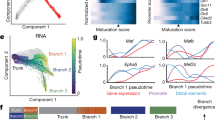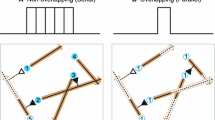Abstract
The mammalian cortex is divided into architectonic and functionally distinct areas. There is growing experimental evidence that their emergence and development is controlled by both epigenetic and genetic factors. The latter were recently implicated as dominating the early cortical area specification. In this paper, we present a theoretical model that explicitly considers the genetic factors and that is able to explain several sets of experiments on cortical area regulation involving transcription factors Emx2 and Pax6, and fibroblast growth factor FGF8. The model consists of the dynamics of thalamo-cortical connections modulated by signaling molecules that are regulated genetically, and by axonal competition for neocortical space. The model can make predictions and provides a basic mathematical framework for the early development of the thalamo-cortical connections and area patterning that can be further refined as more experimental facts become known.
Similar content being viewed by others
References
Bishop KM, Goudreau G, O'Leary DD (2000) Regulation of area identity in the mammalian neocortex by Emx2 and Pax6. Science 288: 344–349.
Bishop KM, Rubenstein JLR, O'Leary DD (2002) Distinct actions of Emx1, Emx2 and Pax6 in regulating the specification of areas in the developing neocortex. J. Neurosci. 22: 7627–7638.
CohenTannoudji M, Babinet C, Wassef M (1994) Early determination of a mouse somatosensory cortex marker. Nature 368: 460–463.
Feldheim DA, et al. (2000) Genetic analysis of ephrinA2 and ephrinA5 shows their requirement in multiple aspects of retinocollicular mapping. Neuron, 25: 563–574.
Finlay BL, Darlington RB (1995) Linked regularities in the development and evolution of mammalian brains. Science 268: 1578–1584.
Fraser SE, Hunt RK (1980) Retinotectal specificity: Models and experiments in search of a mapping function. Annu. Rev. Neurosci. 3: 319–352.
FukuchiShimogori T, Grove EA (2001) Neocortex patterning by the secreted signaling molecule FGF8. Science 294: 1071–1074.
FukuchiShimogori T, Grove EA(2003) Emx2 patterns the neocortex by regulating FGF positional signaling. Nature Neurosci. 6: 825–831.
Garel S, Huffman KJ, Rubenstein JLR (2003) Molecular regionalization of the neocortex is disrupted in FGF8 hypomorphic mutants. Development 130: 1903–1914.
Gierer A (1983) Model for the retinotectal projection. Proc. R. Soc. Lond. B 218: 77–93.
Goodhill GJ, Richards LJ (1999) Retinotectal maps: Molecules, models and misplaced data. Trends Neurosci. 22: 529–534.
Grove EA, FukuchiShimogori T (2003) Generating the cerebral cortical area map. Annu. Rev. Neurosci. 26: 355–380.
Hofman MA (1989) On the evolution and geometry of the brain in mammals. Prog. Neurobiol. 32: 137–158.
Karbowski J (2003) How does connectivity between cortical areas depend on brain size? Implications for efficient computation. J. Comput. Neurosci. 15: 347–356.
Katz LC, Shatz CJ (1996) Synaptic activity and the construction of cortical circuits. Science 274: 1133–1138.
Knoll B, Drescher U (2002) EphrinAs as receptors in topographic projections. Trends Neurosci. 25: 145–149.
Krubitzer L (1995) The organization of neocortex in mammals: Are species differences really so different? Trends Neurosci. 18: 408–417.
Krubitzer L, Huffman KJ (2000) Arealization of the neocortex in mammals: Genetic and epigenetic contributions to the phenotype. Brain Behav. Evol. 55: 322–335.
LopezBendito G, Molnar Z (2003) Thalamocortical development: How are we going to get there? Nature Rev. Neurosci. 4: 276–289.
Mackarehtschian K, Lau CK, Caras I, McConnel SK (1999) Regional differences in the developing cerebral cortex revealed by Ephrin-A5 expression. Cereb. Cortex 9: 601–610.
Mallamaci A, Muzio L, Chan CH, Parnavelas J, Boncinelli E (2000) mutant mice. Nature Neurosci. 3: 679–686.
Mann F, Peuckert C, Dehner F, Zhou R, Bolz J (2002) Ephrins regulate the formation of terminal axonal arbors during the development of thalamocortical projections. Development 129: 3945–3955.
McLaughlin T, Hindges R, O'Leary DDM (2003) Regulation of axonal patterning of the retina and its topographic mapping in the brain. Curr. Opin. Neurobiol. 13: 57-69
MiyashitaLin EM, Hevner R, Wassarman KM, Martinez S, Rubenstein JLR (1999) Early neocortical regionalization in the absence of thalamic innervation. Science 285: 906–909.
Murray JD (1993) Mathematical Biology.Springer-Verlag, Berlin, pp. 109–139.
Muzio L et al. (2002) Emx2 and Pax6 control regionalization of the preneuronogenic cortical primordium. Cereb. Cortex 12: 129–139.
Nakagawa Y, Johnson JE, O'Leary DDM (1999). Graded and areal expression patterns of regulatory genes and cadherins in embryonic neocortex independent of thalamocortical input. J. Neurosci. 19: 10877–10885.
Nauta WJH, Feirtag M (1986) Fundamental Neuroanatomy. (Freeman, New York)
Northcutt RG, Kaas JH (1995) The emergence and evolution of mammalian neocortex. Trends Neurosci. 18: 373–379.
O'Leary DDM (1989) Do cortical areas emerge from a protocortex? Trends Neurosci. 12: 400–406
O'Leary DDM, Yates PA, McLaughlin T (1999) Molecular development of sensory maps: Representing sights and smells in the brain. Cell 96: 255–269.
O'Leary DDM, Nakagawa Y (2002) Patterning centers, regulatory genes and extrinsic mechanisms controlling arealization of the neocortex. Curr. Opin. Neurobiol. 12: 14-25.
Prestige MC, Willshaw DJ (1975) On a role for competition in the formation of patterned neural connexions. Proc. Roy. Soc. Lond. B 190: 77-98.
Rakic P (1988) Specification of cerebral cortical areas. Science 241: 170–176.
Simon DK, O'Leary DDM (1992) Development of topographic order in the mammalian retinocollicular projection. J. Neurosci. 12: 1212–1232.
Sperry RW (1963) Chemoaffinity in the orderly growth of nerve fibers patterns and connections. Proc. Natl. Acad. Sci. USA 50: 703–710.
Takemoto M et al. (2002) EphrinB3EphA4 interactions regulate the growth of specific thalamocortical axon populations in vitro. Eur. J. Neurosci. 16: 1168–1172.
Uziel D et al. (2002) Miswiring of limbic thalamocortical projections in the absence of ephrinA5. J. Neurosci. 22: 9352–9357.
Vanderhaeghen P et al. (2000) A mapping label required for normal scale of body representation in the cortex. Nature Neurosci. 3: 358–365.
Whitelaw VA, Cowan JD (1981) Specificity and plasticity of retinotectal connections: A computational model. J. Neurosci. 1: 1369–1387.
Wolpert L (1969). Positional information and spatial pattern of cellular differentiation. J. Theor. Biol. 25: 1–47.
Wolpert L (1996). One hundred years of positional information. Trends Genet. 12: 359–364.
Yates PA, Roskies AL, McLaughlin T, O'Leary DDM (2001) Topographicspecific axon branching controlled by ephrinAs is the critical event in retinotectal map development. J. Neurosci. 21: 8548–8563.
Yates PA, Holub AD, McLaughlin T, Sejnowski TJ, O'Leary DDM (2004) Computational modeling of retinotopic map development to define contributions of EphAEphrinA gradients, axonaxon interactions, and patterned activity. J. Neurobiol. 59: 95–113.
Author information
Authors and Affiliations
Rights and permissions
About this article
Cite this article
Karbowski, J., Ermentrout, G. Model of the Early Development of Thalamo-Cortical Connections and Area Patterning via Signaling Molecules. J Comput Neurosci 17, 347–363 (2004). https://doi.org/10.1023/B:JCNS.0000044876.28268.18
Issue Date:
DOI: https://doi.org/10.1023/B:JCNS.0000044876.28268.18




